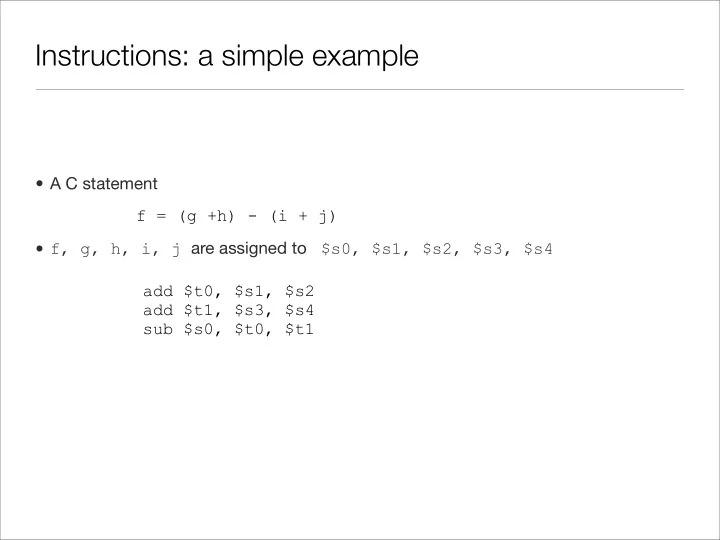

Instructions: a simple example • A C statement f = (g +h) - (i + j) • f, g, h, i, j are assigned to $s0, $s1, $s2, $s3, $s4 add $t0, $s1, $s2 add $t1, $s3, $s4 sub $s0, $t0, $t1
Load and store instructions • Load and store instructions • lw $tn, c_off($S_base) $tn : destination register $S_base : register with base address • sw $tn, c_off($S_base) c_off : offset from base • Example: � C code: �� g = h + A[8]; g : $s1 h : $s2 � MIPS code: � lw $t0, 32($s3) base address of A : $s3 add $s1, $s2, $t0 • Spilling registers doubly slow • 11
Load and store instructions • Example: � C code: �� A[12] = h + A[8]; � MIPS code: � lw $t0, 32($s3) add $t0, $s2, $t0 sw $t0, 48($s3) • Store word has destination last • Remember: arithmetic operands are registers , not memory! � Can’t write: � add 48($s3), $s2, 32($s3)
So far we’ve learned: • MIPS � — loading words but addressing bytes � — arithmetic on registers only • Instruction � � � Meaning add $s1, $s2, $s3 $s1 = $s2 + $s3 sub $s1, $s2, $s3 $s1 = $s2 – $s3 lw $s1, 100($s2) $s1 = Memory[$s2+100] sw $s1, 100($s2) Memory[$s2+100] = $s1 13
Constants • To use a constant, have to use memory, just like for variables • Example: add 4 to register $s3 lw $t0, AddrConstant4($s1) # t0 is the constant 4 add $s3, $s3, $t0 • Quick add instruction: addi addi $s3, $s3, 4 • Design principle: make the common case fast
Representing Instructions in the Computer Machine Language • Instructions, like registers and words (data), are also 32 bits long – Example: add $t0, $s1, $s2 – registers must have numbers (why?) $t0=8, $s1=17, $s2=18 • Instruction Format : 0 18 0 32 17 8 � 000000 10001 10010 � 01000 � 00000 � 100000 � op � rs � rt � rd � shamt � funct op 6-bits opcode that specifies the operation rs 5-bits register file address of the first source operand rt 5-bits register file address of the second source operand rd 5-bits register file address of the result’s destination shamt 5-bits shift amount (for shift instructions) funct 6-bits function code augmenting the opcode 15
Aside: MIPS Register Convention Register Preserve on Name Usage Number call? $zero 0 constant 0 (hardware) n.a. $at 1 reserved for assembler n.a. $v0 - $v1 2-3 returned values no $a0 - $a3 4-7 arguments yes $t0 - $t7 8-15 temporaries no $s0 - $s7 16-23 saved values yes $t8 - $t9 24-25 temporaries no $gp 28 global pointer yes $sp 29 stack pointer yes $fp 30 frame pointer yes $ra 31 return addr (hardware) yes
Machine Language • What if an instruction needs longer fields • e.g.: in lw , address of constant may be more than 32 (2 5 ) • conflict: keep instruction length same vs. have a single instruction format • New principle: Good design demands a compromise • Here: different formats for different instructions (keep length same) • Introduce a new type of instruction format – I-format for data transfer instructions and immediate instructions – other format was R-format for register • Example: lw $t0, 44($s3) � 35 � 19 � 9 � 44 � op � rs � rt � 16 bit number 17
Stored Program Concept • Instructions are bits • Programs are stored in memory � — to be read or written just like data Memory Processor memory for data, programs, compilers, editors, etc. • Fetch & Execute Cycle – Instructions are fetched and put into a special register – Bits in the register "control" the subsequent actions – Fetch the “next” instruction and continue 18
Basic MIPS instructions encoding Format op rs rt rd shamt funct address Instruction R 0 reg reg reg 0 32 n.a. add R 0 reg reg reg 0 34 n.a. sub I 8 reg reg n.a. n.a. n.a. constant addi I 35 reg reg n.a. n.a. n.a. address lw I 43 reg reg n.a. n.a. n.a. address sw
Finally: Programmer to Computer A[300] = h + A[300] $t1 holds base of array A $s2 holds h lw $t0, 1200($t1) add $t0, $s2, $t0 sw $t0, 1200($t1) address/ op rs rt rd funct shamt 35 9 8 1200 0 18 8 8 0 32 43 9 8 1200 100011 1001 1000 0000 0100 1011 0000 0 10010 0 100 0 100 0 100000 101011 1001 0 100 0000 0100 1011 0000
Recommend
More recommend